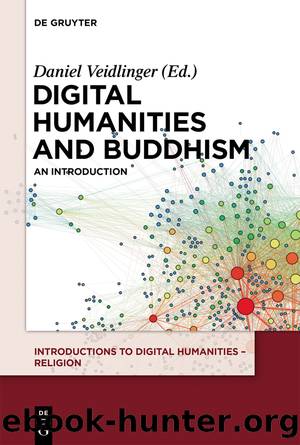Digital Humanities and Buddhism by Daniel Veidlinger

Author:Daniel Veidlinger
Language: eng
Format: epub
Publisher: Walter de Gruyter
Published: 2019-06-15T00:00:00+00:00
These nine Mahāyāna Buddhist texts are still being studied and worshipped in Nepal today. They are not considered to be the canon of a particular lineage or sect, but according to J. K. Nariman, their role is not less than that of a canon in Newar Buddhism (Nariman 1992, 64). Brian Hodgson conveyed the idea that “Vaipulya, treat of several sorts of Dharma and Artha, that is, of the several means of acquiring the goods of this world (Artha) and of the world to come (Dharma)”(Hodgson and Denwood 1972, 15). However, according to Nariman, “These so-called Nine dharmas are no canon of any sect, but a series of books which have been composed at different periods and belong to different persuasions, though all of them enjoy high veneration in Nepal today” (Nariman, 1992, 64).
Thus it is legitimate to claim that Newar Buddhism is a variety of Sanskrit Buddhism and its collections of Buddhist texts can together be called a Sanskrit Buddhist canon. Most of the Buddhist texts used by Newar Buddhists are in the original Sanskrit language, while the Newar language is used for translation, explanation or original material. Min Bahadur Shakya says: “Another peculiarity of Newar Buddhism is its ritual and its sacred literature which are written in the Sanskrit language, because of which we can call Newar Buddhism a ‘Sanskrit Buddhism’ “ (Shakya 2000, 2). Living Sanskritic Buddhism can at present be observed only in the Kathmandu Valley. From birth to death rituals, all the sacraments are being conducted according to the Buddhist manuals in Sanskrit. Many local Buddhist tales and legends are preserved in purāṇas and māhātmyas written in Sanskrit. In this way Sanskrit is the medium that has traditionally united Buddhist Newars in the Kathmandu Valley. It is not necessary to maintain a sectarian identity in order to follow the Sanskrit tradition. Iain Sinclair points out that “Although Newar Buddhism does not see itself as part of a classical nikāya organization, some of its core processes can be identified with the Mūlasarvāstivādanikāya. The procedure for monastic ordination follows a Mūlasarvāstivādin handbook which was long ago absorbed into a tantric ritual digest created in Nepal” (Sinclair 2016, 14).
Hence, the DSBC is not trying to create a radically new form of Sanskrit Tripiṭaka, but rather is attempting to revive the old Sanskrit Tripiṭaka with the material available today. It is a painstaking task, because this material is so dispersed and fragmented, but the project assumes that further loss can be prevented by quick action.
Download
This site does not store any files on its server. We only index and link to content provided by other sites. Please contact the content providers to delete copyright contents if any and email us, we'll remove relevant links or contents immediately.
Cecilia; Or, Memoirs of an Heiress — Volume 1 by Fanny Burney(31333)
Cecilia; Or, Memoirs of an Heiress — Volume 3 by Fanny Burney(30934)
Cecilia; Or, Memoirs of an Heiress — Volume 2 by Fanny Burney(30889)
The Great Music City by Andrea Baker(21318)
We're Going to Need More Wine by Gabrielle Union(18074)
Bombshells: Glamour Girls of a Lifetime by Sullivan Steve(13109)
Pimp by Iceberg Slim(12932)
All the Missing Girls by Megan Miranda(12752)
Fifty Shades Freed by E L James(12451)
Norse Mythology by Gaiman Neil(11884)
Talking to Strangers by Malcolm Gladwell(11879)
Crazy Rich Asians by Kevin Kwan(8351)
Mindhunter: Inside the FBI's Elite Serial Crime Unit by John E. Douglas & Mark Olshaker(7834)
The Lost Art of Listening by Michael P. Nichols(6474)
Enlightenment Now: The Case for Reason, Science, Humanism, and Progress by Steven Pinker(6406)
Bad Blood by John Carreyrou(5770)
The Four Agreements by Don Miguel Ruiz(5511)
Weapons of Math Destruction by Cathy O'Neil(5038)
We Need to Talk by Celeste Headlee(4871)
